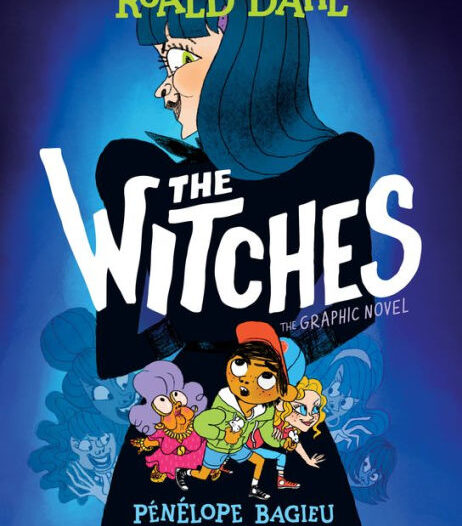
Review: ‘The Witches: The Graphic Novel’

The Witches: The Graphic Novel
Writer/artist: Pénélope Bagieu
Scholastic; $14.99
As Roald Dahl’s children’s novels go, 1983’s The Witches is not the most adaptation-ready, particularly if the adaptation in question is into the highly visual medium of comics. The book is told in first-person narration by its little-boy protagonist, and much of the first two-thirds or so of the book are the boy’s recounting of things he heard.
First, there’s a long passage in which his grandmother, a retired “witchophile,” tells him everything she knows about witches, who, it turns out, are quite real, quite different than the witches you might have heard about in other stories, and quite a danger to all children everywhere. That’s followed by another long passage in which the boy stumbles upon a meeting of all the witches in England, lead by The Grand High Witch herself, in which he relates the entirety of her speech to the reader. They’re quite lively and engaging in prose, but they don’t lend themselves to scores and scores of panels.
ADVERTISEMENT
ADVERTISEMENT
Cartoonist Pénélope Bagieu, whose previous work includes Brazen and California Dreamin‘, tackles this challenge in an interesting way, condensing a great deal of these particularly talky passages of the source novel, and expanding other portions of the novel through original, and particularly comic book-y, passages.
So, for example, the graphic novel opens with an original nine-page sequence, in which we meet our protagonist playing with a couple of toys, including a Margaret Hamilton-like witch, just after his parents’ funeral, and then watch as his grandmother, whom he calls Grandmama and who adopts and cares for him, awkwardly attempts to comfort him. Later, when she begins to explain how to spot a witch to him, Bagieu lays out all of the physical differences in just two pages, the graphic novel adopting the form of a textbook full of figures.
There are some changes that have nothing to do with the challenges of adaptation, though. The most immediate one is previewed on the cover. Bruno Jenkins, the Augustus Gloop-like little boy who gets turned into a mouse by the Grand High Witch during her speech, has been excised and replaced by a little girl. She lacks Bruno’s various nasty qualities and is a much more active participant in the proceedings, teaming up with our boy hero and even taking some pains to cheer him up when he gets turned into a mouse.
This adds a second sympathetic female character to the proceedings, I suppose, and gives girls reading the adaptation a character they can identify more directly with, but it also warps elements of the book. It softens some of the pointiest edge in Dahl’s book, drains our hero of some his admirable pluck, and, in a rather strange move, it adds a romantic sub-plot involving two eight-year-old children who get turned into mice, which it’s hard to imagine anyone in the target audience being too terribly excited about.
Bagieu’s art style, which is here a bit looser than in her previous work, is rather well suited to the source material. While one wouldn’t mistake her designs or her rendering for that of Quentin Blake, the artist who provided illustrations for The Witches and who is most associated with Dahl’s books, her style isn’t a world away from his, either. In fact, she seems to draw more Blake-like here than elsewhere. Both artists produce work that has a dashed-off quality to it, one that belies the careful construction beneath the lines as they appear.
Bagieu’s adaptation shouldn’t be regarded as a substitute for Dahl’s novel, but, like the various movie adaptations of his books, should instead be seen as a companion to its source material.
In that regard, it is plenty of fun to see how Bagieu imagines the various characters and the more spectacular imagery, particularly the true face of the Grand High Witch, a face so horrible that the book’s narrator had trouble putting it into words, or her take on Grandmama as a tiny, child-sized, irrepressible woman who is more than a match for the most evil and powerful witch in the world.
As is so often said of film adaptations, I think the book was better, but that doesn’t mean the graphic novel is bad, just different.
Filed under: Graphic Novels, Reviews
About J. Caleb Mozzocco
J. Caleb Mozzocco is a way-too-busy freelance writer who has written about comics for online and print venues for a rather long time now. He currently contributes to Comic Book Resources' Robot 6 blog and ComicsAlliance, and maintains his own daily-ish blog at EveryDayIsLikeWednesday.blogspot.com. He lives in northeast Ohio, where he works as a circulation clerk at a public library by day.
ADVERTISEMENT
ADVERTISEMENT
SLJ Blog Network
One Star Review, Guess Who? (#202)
This Q&A is Going Exactly As Planned: A Talk with Tao Nyeu About Her Latest Book
Parsing Religion in Public Schools
Environmental Mystery for Middle Grade Readers, a guest post by Rae Chalmers
ADVERTISEMENT








I liked the graphic novel. It was exiting and I think 7 yrs and over can read this “comic”.
If you like exiting and suspenseful graphic novels… you should read this book.
Hope you will read it!!!
😁